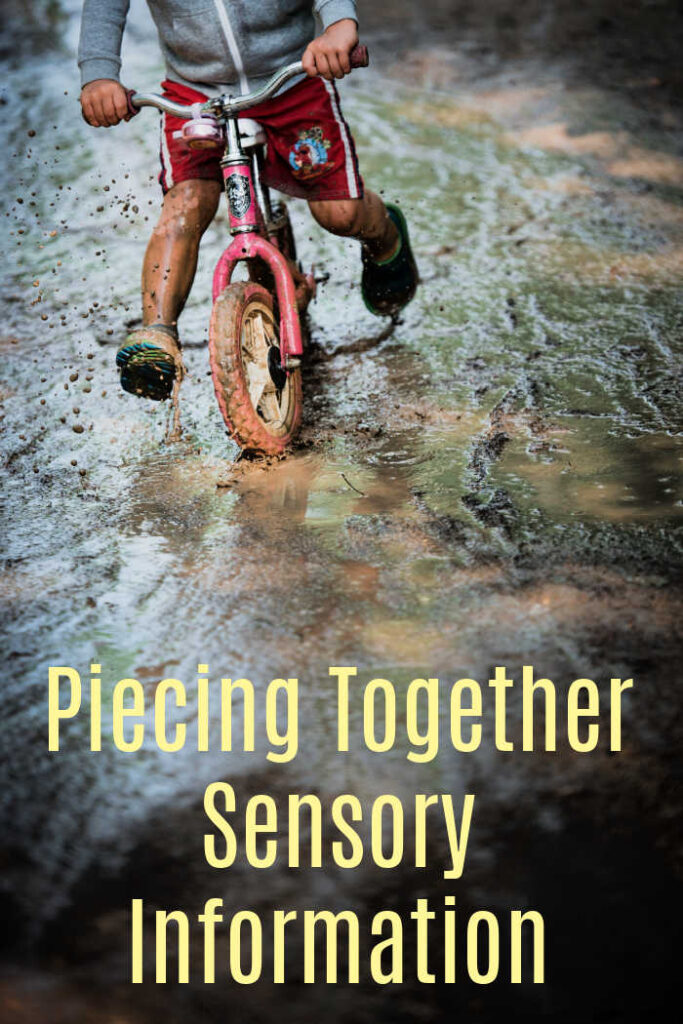Piecing Together Sensory Information
I have learned a few important lessons about sensory processing and now share how to piece sensory information together with you in hopes of helping you avoid the same mistakes.
This post contains affiliate links.
Riding tricycles naked over every crack in the driveway.
Sound strange to you?
It did to me for the first three years of my son’s life.
All I knew was that his happy place was in front of our house riding his tricycle to his heart’s content over every single crack all day long.
When we were inside he was typically crying, having meltdowns or eating.
That basically covers most of what we did up until he was three, which is when the sensory lightbulb went on.
This might sound like a typical story of a mom who knew nothing about sensory information then one day heard about it and everything started to click.
But that isn’t the case.
This is my story and I had spent the previous 4 years working full time with children just like my son.
I knew all about sensory processing, I simply didn’t apply it in the one place it mattered most, my own home.
Thankfully I have been able to learn a few important lessons from my situation and now share them with you in hopes of helping you avoid the same mistakes.

Acquiring information and Applying information are two VERY different skills
As a teacher I knew about sensory differences.
I could identify them, address them, and explain them when needed.
As a teacher I also knew my sole responsibility was my class.
While I was there I focused on my students, and only them.
I had help with me at all times.
I was in my zone, I had the support, I had the knowledge, and I knew what to do.
At work I acquired information and used it daily while I was in my distraction-free zone.
At home things are very different.
In my home I have more than one role; I am responsible for the dishes, laundry, mopping, vacuuming, cooking, running errands, raising children, and trying to stay sane. It’s exhausting to juggle it all.
Taking the time to analyze each tantrum and calmly respond to it in the heat of the moment while cooking lunch and trying to entertain another child is simply unthinkable.
During those first three years I was doing what most moms do; survive.
Applying any information I had once acquired was out of the question and didn’t happen until I forced myself to approach it all from a different angle.
Understanding Sensory Information rather than Controlling
During those chaotic we experienced daily tantrums, unpredictable behavior, and strange mannerisms, my first motherly response was to fix it or make it stop.
As a mom I felt responsible for my kids’ behavior.
I felt that if my children misbehaved it was a reflection of my poor parenting skills.
As a result, I tried to control or change their behavior.
It’s no wonder my sweet son had a rough 3 years, I was trying to fix his behaviors when in reality, his behaviors weren’t what needed to be fixed.
Once I changed my mindset I started looking at my son’s behavior as something I needed to understand rather than control.
After looking at it this way I could see clearly that his needs weren’t being.
As a result of this his body reacted negatively in the form of tantrums and lots of screaming.
My son’s behaviors weren’t the problem, the environment was.
I had been trying to fix the wrong thing.
It was then that I realized I had all the knowledge of parenting and sensory processing, I just didn’t know how to apply it in my own home.
Once I started looking at my son’s behavior in this light I was able to start my journey of truly understanding his sensory needs and working to support him in every way possible.
Embrace the Imperfection
My journey is not a picture perfect journey, but it is one I am now grateful for because it has shaped the way I now view parenting… particularly parenting children with sensory differences.
During the past two years our days have been filled with more love and understanding than ever before.
We still have tantrums, meltdowns, and difficulties fairly regularly.
Those are things I can’t wish away and will always be part of our life.
Kids aren’t perfect and they get upset, especially kids with sensory differences.
Moms aren’t perfect, we make mistakes, we can’t be 100% consistent and on top of every situation that arises at any moment.
That is life.
Now I embrace this.
I accept it as part of our process of growing and becoming better together.
About the Guest Author
This post originally appeared on WendyBertagnole.com and is reprinted with permission.
With an undergraduate degree in child development, and a master’s degree in special education, this foundation was a springboard for Wendy in helping kids and families to see the root of any challenges they face.
